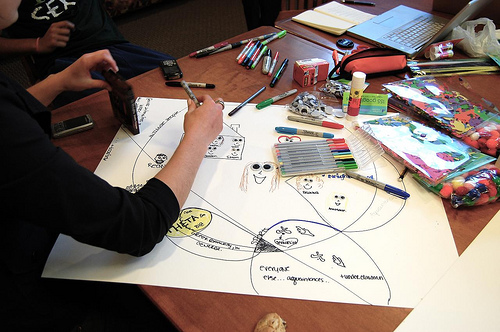

This blog post is an introduction to Participatory Design (PD) (a UX Design process/strategy) and the methodologies that encompass PD. This is the first in a series of PD themed blog posts, so stay tuned for the next installment!
Participatory Design, User-Centered Design, and Human-Centered Design, all refer to methods which involve users and stakeholders during the iterative design process in hopes of meeting the wants, needs, and affordances of end-users. Participatory Design can be implemented in a variety of ways depending on what type of information the team is trying to capture– from design requirements to usability, the choice is yours.
Participatory Design was initially used in the design and development of computer applications and systems in Scandinavia and was referred to as Cooperative Design (Bødker et al., 2004). As the theory moved westward to the US, the term Participatory replaced Cooperative due to the nature of the first applications in business and the need to stress the vested interest of the participants.

The primary goal of PD is to help provide greater consideration and understanding of the needs and wants of system users. Participatory Design can be used to carefully integrate the needs, perspectives, and contexts of stakeholders, therefore, increasing the likelihood of diffusion, adoption, and impact of the resulting user-centered system.
For example, the design of a new mobile yellow page application created to target certain populations and connect users with providers. Wouldn’t it make sense to involve the end-users of this application from the onset of the project? Absolutely! Again, PD can be implemented in a variety of forms, for this example let’s assume we begin by asking our end-users to participate in a design needs session where the design team meets with end-users and fleshes out the necessary design requirements for the mobile app. From the beginning of the project, the users will have their voice heard and incorporated into the design of the final system.
Iterative Usability Testing is paramount to the success of any system, and this is another point where users can assist the design team in shaping the usability of the system. By conducting iterative usability tests, perhaps as short weekly lean UX sprints, the design team and engineers can quickly test and iterate the design of a new system- and be agile in the process.
IDEO has put together its own version of a ‘Human Centered Design Toolkit’. Check it out. Lots of cool techniques, tips, and more to get yourself in the HCD head space.
Remember: by incorporating your users feedback throughout the creation of your system, you are moving towards a better design and adopted system for all stakeholders.
If you have any questions, or want to talk Participatory Design, reach out to us info@keylimeinteractive.com
Bødker, K., Kensing, F., and Simonsen, J. (2004). Participatory IT design: Designing for business and workplace realities. Cambridge, MA, USA: MIT Press.










Comments
Add Comment